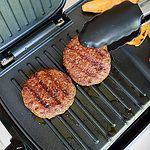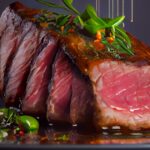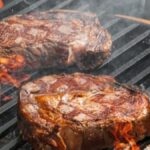Grilling the Perfect Steak on a George Foreman Grill – Timing is Everything!
As a chef, I get asked all the time how long to cook steak on a George Foreman grill. And let me tell you, timing is everything when it comes to grilling the perfect steak. Whether you prefer your steak medium-rare, well-done, or somewhere in between, there are a few key factors to consider when it comes to grilling on a George Foreman.
First and foremost, let’s talk about the type of steak you’re grilling. Different cuts of steak have different levels of fat and marbling, which can affect the cook time. Some of the best steaks to grill on a George Foreman include ribeye, new york strip, sirloin, t-bone, filet mignon, skirt steak, flank steak, and even chicken breasts or fish fillets. Thicker steaks, like ribeye or t-bone, will take longer to cook than thin cuts like skirt steak or flank steak.
When choosing a steak for the George Foreman grill, it’s important to consider the thickness of the meat as well as the level of fat content. Thicker steaks with a higher fat content, like ribeye or sirloin, will result in a juicier and more flavorful steak. Thinner cuts with less fat, like a skirt steak or flank steak, will cook more quickly and may require less grilling time.
Cooking Ribeye Steaks on a George Foreman Grill
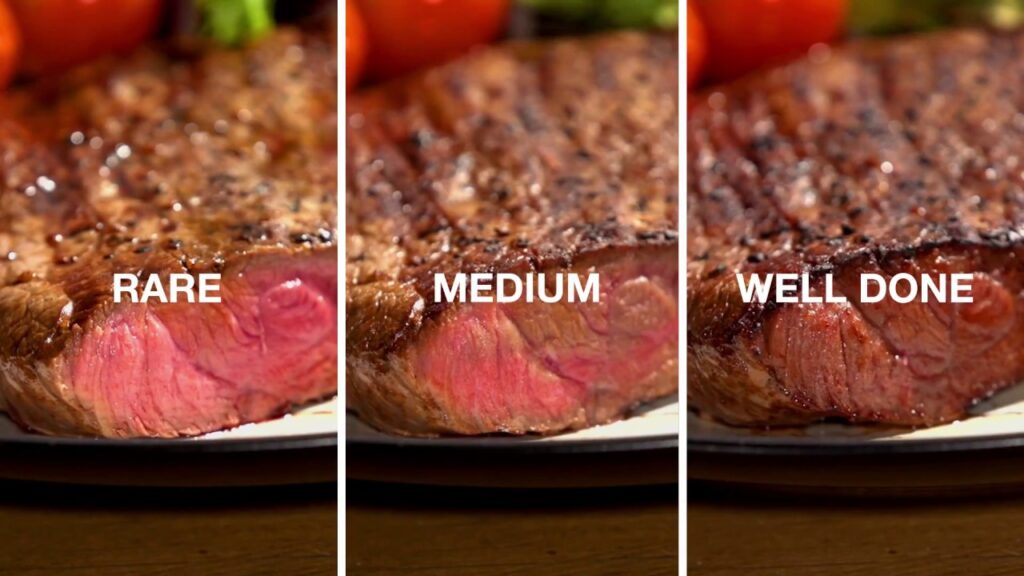
Ribeye steaks are a great choice for grilling on a George Foreman, as they have a high fat content and are known for their rich, beefy flavor. To achieve a medium-rare ribeye, start by setting your George Foreman to a high heat setting and allowing it to preheat. Coat the steak in a little vegetable oil and season with your desired spices. Place the ribeye on the grill, making sure to get direct contact with the heating element for an even cook. Grill for about 5-7 minutes per side, or until the internal temperature reaches 135-140 degrees Fahrenheit for medium-rare. Be sure to use a meat thermometer to ensure the desired level of doneness.
Now, let’s talk about timing. The exact cooking time will depend on the thickness of the steak and the desired level of doneness. As a general rule of thumb, thin steaks (around 1-inch thick) will take about 4-7 minutes per side to reach medium-rare, while thicker steaks (1.5-2 inches) will take closer to 7-9 minutes per side. Keep in mind that these are just estimates, and it’s always a good idea to use a meat thermometer to ensure your steak is cooked to your desired level of doneness.
Achieving the Perfect Steak on a George Foreman Grill
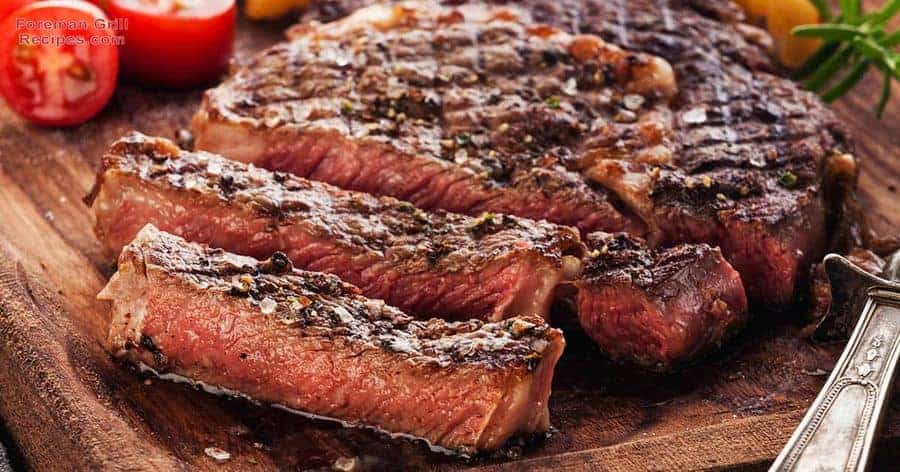
Timing is everything when it comes to grilling the perfect steak on a George Foreman. Be sure to set your grill to the proper heat setting and allow it to preheat before adding the steak. A non-stick surface will make it easier to remove the steak once it’s finished cooking. Place the steak on the grill and close the lid, allowing it to cook for the desired length of time. An indicator light or a meat thermometer can help you to monitor the progress of the steak and ensure it is cooked to your desired level of doneness.
To add some extra flavor to your steak, try seasoning it with black pepper and kosher salt before grilling. A little meat tenderizer or a marinade of soy sauce can also add some extra richness to the flavor. For an extra flavorful and juicy steak, be sure to allow the fat to melt and drip away during the grilling process. This will help to add extra richness to the flavor of the meat.
It’s also important to allow the steak to rest for a few minutes after grilling. This will allow the juices to redistribute throughout the meat, resulting in a juicier steak. Additionally, be sure to keep an eye on the fat drips and use a drip tray to prevent flare-ups on the grill.
Another factor that can impact grill time is the type of grill you’re using. An outdoor grill, electric grill, or indoor grill will all have different temperature settings and heating elements, so the cook time may vary. Similarly, non-stick surfaces and grill plates can also impact the cook time. For the best results, try to get direct or dual contact with the heating element for an even cook.
Internal temperature is also an important factor when it comes to grilling steak. For medium-rare, you’ll want to aim for an internal temperature of 135-140 degrees Fahrenheit. For well-done, aim for 155-165 degrees Fahrenheit. A meat thermometer is a handy tool to have in the kitchen to ensure your steak is cooked to your desired level of doneness.
Grilling Steak Indoors with a George Foreman Grill
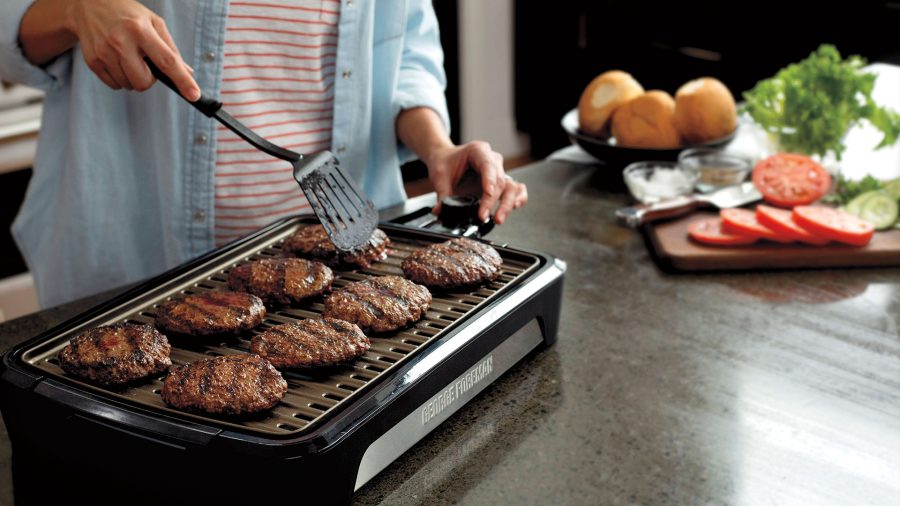
If you don’t have access to an outdoor grill or the weather isn’t cooperating, don’t worry – you can still achieve great results by grilling steak indoors with a George Foreman grill. Start by setting the grill to a high heat setting and allowing it to preheat. Coat the steak in a little nonstick cooking spray or vegetable oil and season with your desired spices. Place the steak on the grill, making sure to get good contact with the heating element. Grill for the desired length of time, using an indicator light or meat thermometer to monitor the progress of the steak. When the steak is finished cooking, remove it from the grill and let it rest for a few minutes before serving. This will give you a flavorful and juicy steak without having to brave the elements.
In conclusion, timing is everything when it comes to grilling the perfect steak on a George Foreman grill. Be sure to choose a high-quality cut of meat, set the grill to the proper heat setting, and use the right grilling techniques. With a little bit of know-how, you can achieve a delicious and perfectly cooked steak every time. So the next time you’re in the mood for a flavorful and juicy steak, be sure to give the George Foreman grill a try. You might be surprised at just how easy it is to achieve restaurant-quality results right in the comfort of your own home.
Bonus Tips:
Olive Oil – The Secret Ingredient for Grilling the Perfect Steak on a George Foreman Grill
If you’re looking to add some extra flavor and moisture to your grilled steak, try using olive oil as a marinade or seasoning. Olive oil is rich in healthy monounsaturated fats and has a distinct, flavorful taste that pairs well with steak. Simply coat the steak in a little olive oil before grilling, or marinate it in a mixture of olive oil, garlic, and herbs for a few hours before cooking. The added fat and moisture from the olive oil will help to keep the steak juicy and flavorful as it cooks.
Recommended Grilling Times for Steak on a George Foreman Grill
Generally speaking, thinner steaks (around 1-inch thick) will take about 4-7 minutes per side to reach medium-rare on a George Foreman grill, while thicker steaks (1.5-2 inches) will take closer to 7-9 minutes per side. However, these are just estimates and the actual cook time may vary depending on the thickness of the steak, the desired level of doneness, and the type of grill you’re using.
To achieve a medium-rare steak, aim for an internal temperature of 135-140 degrees Fahrenheit. For a well-done steak, aim for 155-165 degrees Fahrenheit. A meat thermometer is a handy tool to have in the kitchen to ensure your steak is cooked to your desired level of doneness.
Summary: Now you know how long to cook steak on a George Foreman grill
Grilling steak indoors with a George Foreman grill is a great option for any occasion. Whether you’re craving a delicious and flavorful steak on a rainy day or just don’t have access to an outdoor grill, the George Foreman is a convenient and easy way to cook up a great steak.
One thing to keep in mind is that the exact cooking time will depend on the thickness of the steak and the desired level of doneness. As a general rule of thumb, thin steaks (around 1-inch thick) will take about 4-7 minutes per side to reach medium-rare, while thicker steaks (1.5-2 inches) will take closer to 7-9 minutes per side. Keep in mind that these are just estimates, and it’s always a good idea to use a meat thermometer to ensure your steak is cooked to your desired level of doneness.
Grilling steak indoors with a George Foreman is also a healthier option compared to other methods of cooking. The grill plates are designed to drain excess fat away from the food as it cooks, resulting in a leaner and healthier version of a grilled steak. Plus, the non-stick surface makes it easy to remove the steak once it’s finished cooking, without the need for added butter or oil.
In the end, the most important thing is to find the cooking method and techniques that work best for you. Whether you prefer a charcoal grill, electric grill, or indoor grill, there are endless options for achieving a delicious and flavorful steak. So don’t be afraid to experiment and try out different methods to find what works best for you. With a little bit of practice and the right tools, you can become a master at grilling the perfect steak on a George Foreman grill.
It’s also worth noting that the cooking process doesn’t end when you remove the steak from the grill. Allowing the steak to rest for a few minutes after grilling is an important step that allows the juices to redistribute throughout the meat, resulting in a juicier and more flavorful steak. Simply place the steak on a paper towel or cutting board and let it sit for about 5-10 minutes before slicing and serving. This is especially important for thicker steaks, as it gives the meat time to finish cooking and allows the fat to melt and drip away.
So the next time you’re in the mood for a delicious and flavorful steak, don’t be afraid to give the George Foreman grill a try. Whether you’re an experienced griller or just starting out, this handy kitchen appliance is a great way to cook up a great steak in no time. Happy grilling!
More George Foreman Grill Recipes and Resource
How To Cook Burgers On a George Foreman Grill
How Long To Cook Steak on George Foreman Grill (Medium, Rare, Well-done)
Timing to Grill Perfect Chicken Breast on a George Foreman Grill
Cooking Pork Chops on a George Foreman Grill: A Step-by-Step Guide
How to Clean a George Foreman Indoor Outdoor Grill: A Chef’s Guide
How to Use George Foreman Grill: Tips and Techniques from a Chef
How To Cook Steak on George Foreman Grill (Temperature, Cuts, Time)

Shara @The Bird BBQ
Shara loves to experiment with different flavors and techniques when it comes to BBQ. She has been perfecting her craft for years and loves hosting backyard BBQs with friends & family. She often comes up with creative recipes that her guests rave about.

